Imaging Resource turned 15 this month, thanks to all of you!
posted Monday, April 1, 2013 at 1:59 PM EDT
It's hard to believe, but it was 15 years ago today that I first brought Imaging Resource live on the Internet. Some say Internet Years are like Dog Years, only more so; by that measure, IR is more like 100 and I don't feel a day over 99.
IR was a classic entrepreneurial startup, beginning its life in a spare bedroom before eventually moving to the basement. Nine years ago this January, we moved it to a building of its own, a 2-bedroom ranch house with a nice big basement that now houses the IR lab.
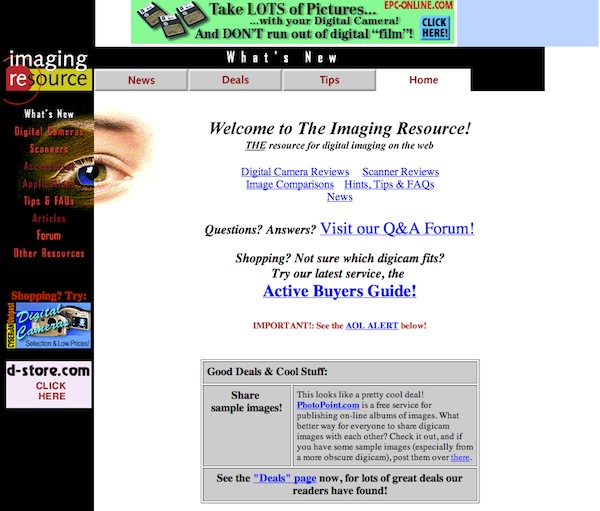
Here's what IR looked like, shortly after launch.
(Back then, I didn't have an ad server, so ads were inserted on pages via batch edits to all the files on the site! Sadly, none of these original advertisers are still in business.)
At first it was just me doing everything, but it wasn't long before current News Editor Mike Tomkins joined me, as well as writer Stephanie Boozer, both of whom continue to be involved. Nowadays, there's a dozen of us who work more or less full-time on the site, plus several freelancers and outside programmers. And we're excited that our latest hire, William Brawley, will be joining the team as Associate Editor tomorrow.
Only possible with much support
If time flies when you're having fun, I must be having a blast, because it doesn't remotely seem like I've been doing this for so long. It's been a great ride: I have great people that I work with, a fantastic community of enormously supportive readers, and a loyal collection of advertisers who support our efforts to educate and inform via our rigorous and objective testing and reporting. I'm deeply grateful to every one of the above. The team here works incredibly hard, but with incredible grace and goodwill towards each other: They make coming to work every day a pleasure, which has a lot to do with why it seems like far less than 15 years that I've been at this.
Our readers are, of course, the ultimate reason IR exists: With out all of you, none of what we do would be possible. I'm deeply appreciative not only for your vast legions, but for the time so many of you have taken to drop an encouraging email, say thanks, support us with a donation, and just generally contribute to the collegiality and good humor of the IR community.
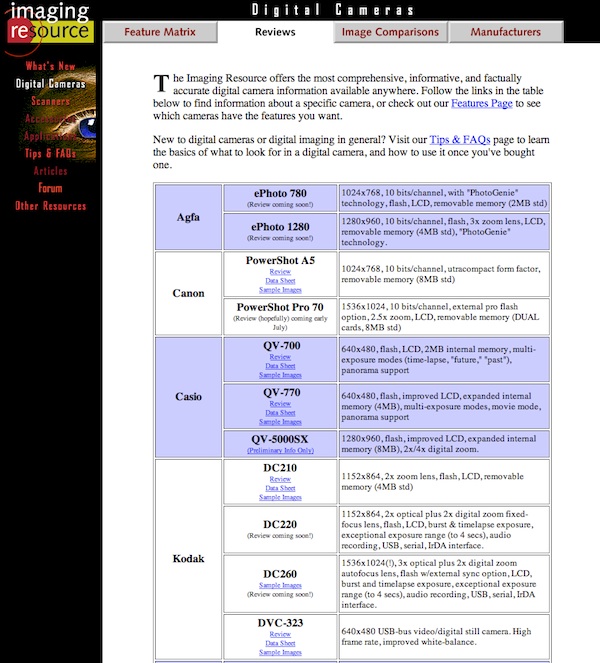
Since the beginning 15 years ago, IR's goal has always been to provide the most comprehensive, informative and accurate digital camera reviews on the web. The camera manufacturers may have changed over the years, but not our mission.
And naturally our advertisers make it all possible, too. We've been genuinely blessed with advertisers who value the service we provide to readers, helping you make more educated camera and gear purchases.
On the one hand, it's amazing that I've never had an advertiser try to change or influence our coverage of their products in any way, regardless of how the reviews might come out. (A PR firm did try to twist my arm once, but I'm pretty sure their client would have been horrified if they'd found out.) Really, though, knowing all the people involved at the various companies, it's no surprise at all: The photo industry is a truly remarkable business, characterized at the highest levels by fair dealing and good will, and that's certainly borne out by all the people I've come to know and appreciate at so many companies over the years.
One of my very first contacts in the industry was Jon Sienkiewicz, then of Minolta, who shared this thought with me at my first PMA in New Orleans in 1998. Paraphrasing heavily, due to the distance in time and my imperfect memory: People don't generally go into things like appliance sales or real estate because they have a passion for their products, but most of the people in the photo business have a real passion for photography. While the realities of business mean that they have to move the products, their motivation for doing so is rooted in sharing and spreading the joy and magic of photography. (Thanks, Jon)
It's a really good group of people, one that I'm hugely grateful to be associated with.
We are family, literally

The most photographed woman on the web? My long-suffering wife Marti, in one of the very first images posted on Imaging Resource. (Shot with the Olympus D-220L)
Of course, there's one group in particular who deserves credit above and beyond all the others -- my family. Many longer-term readers will feel they already know my wife Marti, since she was the long-suffering model for thousands (and thousands) of "indoor portrait" and "outdoor portrait" shots in the earlier years. Marti has managed our accounting since day one, and sons Arthur and Chris have both worked on the site as well.
Arthur now serves as our Director of Development, dragging our software kicking and screaming into the 21st century. Marti, Arthur and Chris have all suffered the usual ups and downs of a small, entrepreneurial business, and having "Dad" or "Hon" perpetually working late and on weekends. I can't say enough how much I appreciate their patience and unflagging support.
And, of course, I couldn't forget our four-legged family members. Many of you know Charlotte the Wonder Dog, who's been chasing frisbees in videos for us for more than a decade. The photo (below, right) shows her coming home for the first time, in late 2001. (Hard to believe she's 11 years old now, and still chasing Frisbees for us.) And then there's our relatively new addition, Yoshi (below, left), a rambunctious pup who's always ready to help a co-worker finish off his lunch. (Sometimes, whether the co-worker wants him to or not.) Even Arthur's pooch, Woolly, stops in most every month to see the team and share his opinions on what we're doing. Safe to say that bringing our dogs to work keeps things in the office exciting -- and helps keep our priorities in order.

Yoshi, Wonder Dog in Training
(And accomplished Lunch Thief)
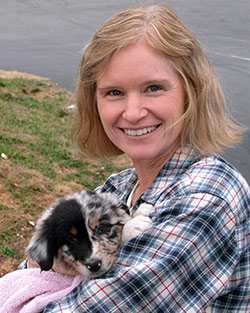
Charlotte the Wonder Dog coming home for the first time in Dec. 2001.
A passion for technology, since Day One
The photo business is also unique in the extent to which it's driven by technology, another passion of mine. I love seeing electronics, device physics and image processing turning into better and better cameras with every year that goes by. IR began right as digital imaging tech was finally making its way into the consumer market, and there's been enormous growth and change in the years since. Looking back, it's literally hard to believe how much the industry has changed.
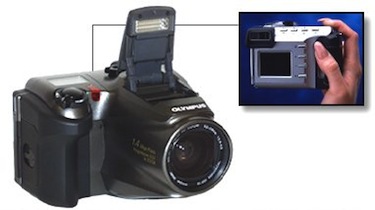
The first reviews posted on the site were for a clutch of Olympus cameras, the D-220L, D-320L, D-500L and D-600L. The Olympus D-600L was quite the choice piece of gear, a real object of envy at the time. It had no fewer than 1.4 Megapixels, a 1.8-inch LCD on the back, a 3x, 36-110mm-equivalent zoom lens, and a snazzy-looking frame reminiscent of Olympus' popular "ZLR" (zoom lens reflex) film cameras. All this for only $1,299 -- crazy! I still have mine, sitting on the IR "museum" shelves in the living room / conference room here.
What's hard to convey is just how utterly cool this camera was back then, how far ahead of the rest of the field it was at the time. I could say that most competing models had VGA-resolution sensors (640x480), but really, there wasn't anything that truly competed with the D-600L at the time; it really stood alone at the top of the digicam market for quite a while.
Other cutting edge cameras and gadgets from 15 years ago
What else was going on back then? Some things were surprisingly advanced for the time, others never made it past the lab.
One of the interesting gadgets in the latter category was the Imagek EFS-1. The concept was to package an image sensor, electronics, and battery into a 35mm film-can sized package that you could just drop into your film SLR, turning it into a digital model. It could shoot 30 images before you'd have to remove it and download the photos to a computer.
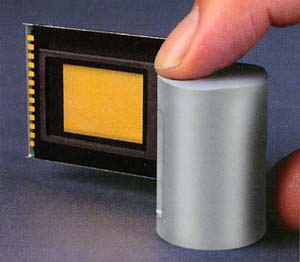
Or, you could just drop in another EFS-1 and keep on rolling, although at a projected price of $1,000 each, I doubt many photographers would have been able to justify a handful to lug along. Perhaps fortunately, no photographer ever had to face that particular budget decision; the EFS-1 never made it as a commercial product.
In the "surprisingly advanced" category was the Casio QV-770. It was only VGA resolution, and had a fixed focal length lens, but offered some unique "timed exposure" modes, as well as in-camera panorama stitching. The timed exposure modes were evidence of Casio's innovation even then, and something that's been a constant of the Casio line ever since.
The timed Exposure modes were what we'd call continuous shooting mode today, with the camera capturing four shots in rapid succession (20 fps!). The real innovation wasn't so much in the idea of continuous shooting, but rather the "past" and "future" modes, which let you capture images either before or after you pressed the shutter button. In the "past" mode, the camera shot continuously at the 20 fps rate, with the images flowing through the buffer, stopping when you pressed the shutter button. As a result, you'd end up with the last four shots it took before you tripped the shutter, a great help when trying to catch fleeting action.
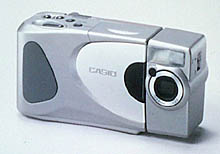
From 1.4 megapixel cameras for $1,300 to vastly more capable 16-megapixel ones for less than $200, it's been a wild ride for all concerned. Look for an ongoing news feature from us, looking at where the industry stood at 5, 10 and 15 years ago and how it's changed.
In 2013, IR feels more vibrant than ever
Another way the business has changed is in its footprint on the Internet. These days, there are myriad individual blogs about most any aspect of photography you care to name, but back then, there were only a few of us.
Sadly, IR seems to be the only site from that era still operating independently. Some great sites have fallen by the wayside and gone dark, while others have been swept up into larger organizations. I suppose that's just the way of things, but it's sad to see it happen, nonetheless.
But with all our recent changes and additions, IR feels more vibrant than ever. We've made a number of upgrades to the site recently, and have a lot more up our sleeve that you'll start seeing over the next month or two. I'm looking forward to 2013 being the best year yet for IR!
Stay tuned, and thanks again for your support!
Dave Etchells
Founder, Publisher, Editor-in-Chief